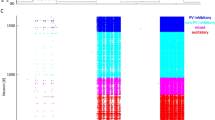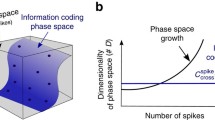Abstract
The problem of the code used by brain to transmit information along the different cortical stages is yet unsolved. Two main hypotheses named the rate code and the temporal code have had more attention, even though the highly irregular firing of the cortical pyramidal neurons seems to be more consistent with the first hypothesis. In the present article, we present a model of cortical pyramidal neuron intended to be biologically plausible and to give more information on the neural coding problem. The model takes into account the complete set of excitatory and inhibitory inputs impinging on a pyramidal neuron and simulates the output behaviour when all the huge synaptic machinery is active. Our results show neuronal firing conditions, very similar to those observed in in vivo experiments on pyramidal cortical neurons. In particular, the variation coefficient (CV) computed for the Inter-Spike-Intervals in our computational experiments is very close to the unity and quite similar to that experimentally observed. The bias toward the rate code hypothesis is reinforced by these results.
This work has been partially supported by a project grant given by Istituto di Cibernetica E. Caianiello for the year 2005.
Preview
Unable to display preview. Download preview PDF.
Similar content being viewed by others
References
Abeles, M.: Role of the cortical neuron: integrator or coincidence detector? Isr. J. Med. Sci. 18, 83–92 (1982)
Abeles, M.: Corticonics: neural circuits of the cerebral cortex, New York, Cambridge (1991)
Amaral, D.G., Ishizuka, N., Claiborne, B.: Neurons, number and the hippocampal network. In: Storm-Mathisen, J., Zimmer, J., Otterson, O.P. (eds.) Progress in Brain Research, vol. 83, pp. 1–11. Elsevier, Amsterdam (1990)
DeWeese, M.R., Wehr, M., Zador, A.M.: Binary spiking in auditory cortex. J. Neurosci. 23, 7940–7949 (2003)
Di Maio, V., Lansky, P., Rodriguez, R.: Different types of noise in leaky-integrate and fire model of neuronal dynamics with discrete periodical input. General Physiology and Biophysics 23, 21–28 (2003)
Forti, L., Bossi, M., Bergamaschi, A., Villa, A., Malgaroli, A.: Loose-patch recordings of single quanta at individual hippocampal synapses. Nature 388, 874–878 (1997)
Gonzales, R.B., DeLeon Galvan, C.J., Rangel, Y.M., Claiborne, B.J.: Distribution of thorny excrescences on CA3 pyramidal neurons in the rat hippocampus. J. Comp. Neurol. 430, 357–368 (2001)
Gerstein, G.L., Mandelbrot, B.: Random walk models for the spike activity of a single neuron. Biophys. J. 71, 41–68 (1964)
Hübener, M., Shoham, D., Grinvald, A., Bonhoeffer, T.: Spatial relationships among three columnar systems in cat area 17. J. Neurosci. 17, 9270–9284 (1997)
Kleppe, I.C., Robinson, H.P.: Determining the activation time course of synaptic AMPA receptors from openings of colocalized NMDA receptors. Biophys. J. 77, 1418–1427 (1999)
Segev, I., Fleshman, J.W., Burke, R.E.: Compartment models of complex neurons. In: Koch, C., Segev, I. (eds.) Methods in Neuronal Modeling, pp. 63–96. MIT Press, Cambridge (1989)
Konig, P., Engel, A.K., Singer, W.: Integrator or coincidence detector? The role of the cortical neuron revisited. Trends Neurosci. 19, 130–137 (1996)
Kuhn, A., Aertsen, A., Rotter, S.: Neuronal integration of synaptic input in the fluctuation-driven regime. J. Neurosci. 24, 2345–2356 (2004)
Lansky, P.: On approximations of Stein’s neuronal model. J. Theor. Biol. 107, 631–647 (1984)
Lansky, P., Lanska, V.: Diffusion approximation of the neuronal model with synaptic reversal potentials. Biol. Cybern. 56, 19–26 (1987)
Matsuda, S., Kobayashi, Y., Ishizuka, N.: A quantitative analysis of the laminar distribution of synaptic boutons in field CA3 of the rat hippocampus. Neurosci. Res. 49, 241–252 (2004)
Megias, M., Emri, Z., Freund, T.F., Gulyas, A.I.: Total number and distribution of inhibitory and excitatory synapses on hippocampal CA1 pyramidal cells. Neuroscience 102, 527–540 (2001)
Ricciardi, L.M., Ventriglia, F.: Probabilistic models for determining the input-output relationship in formalized neurons. I. A theoretical approach. Kybernetik 7, 175–183 (1970)
Salinas, E., Sejnowski, T.J.: Impact of correlated synaptic input on output firing rate and variability in simple neuronal models. J. Neurosci. 20, 6193–6209 (2000)
Shadlen, M.N., Newsome, W.T.: Noise, neural codes and cortical organization. Curr. Opin. Neurobiol. 4, 569–579 (1994)
Shadlen, M.N., Newsome, W.T.: Is there a signal in the noise? Curr. Opin. Neurobiol. 5, 248–250 (1995)
Shadlen, M.N., Newsome, W.T.: The variable discharge of cortical neurons: implications for connectivity, computation, and information coding. J. Neurosci. 18, 3870–3896 (1998)
Softky, W.R.: Simple codes versus efficient codes. Curr. Opin. Neurobiol. 5, 239–247 (1995)
Softky, W.R., Koch, C.: The highly irregular firing of cortical cells is inconsistent with temporal integration of random EPSPs. J. Neurosci. 13, 334–350 (1993)
Stevens, C.F., Zador, A.M.: Input synchrony and the irregular firing of cortical neurons. Nat. Neurosci. 1, 210–217 (1998)
Tsodyks, M.V., Markram, H.: The neural code between neocortical pyramidal neurons depends on neurotransmitter release probability. Proc. Natl. Acad. Sci. U. S. A. 94, 719–723 (1997)
Tuckwell, H.C.: Determination of the inter-spike times of neurons receiving randomly arriving post-synaptik potentials. Biol. Cybern. 18, 225–237 (1975)
Tuckwell Henry, C.: Stochastic Processes in the Neurosciences. Soc. for Industrial and Applied Math., Philadelphia, Penn. USA (1989)
Ventriglia, F.: Saturation in excitatory synapses of hippocampus investigated by computer simulations. Biol. Cybern. 90, 349–359 (2004)
Ventriglia, F., Di Maio, V.: Synaptic fusion pore structure and AMPA receptor activation according to Brownian simulation of glutamate diffusion. Biol. Cybern. 88, 201–209 (2003)
Zador, A.: Impact of synaptic unreliability on the information transmitted by spiking neurons. J. Neurophysiol. 79, 1219–1229 (1998)
Author information
Authors and Affiliations
Editor information
Editors and Affiliations
Rights and permissions
Copyright information
© 2005 Springer-Verlag Berlin Heidelberg
About this paper
Cite this paper
Ventriglia, F., Di Maio, V. (2005). Neural Code and Irregular Spike Trains. In: De Gregorio, M., Di Maio, V., Frucci, M., Musio, C. (eds) Brain, Vision, and Artificial Intelligence. BVAI 2005. Lecture Notes in Computer Science, vol 3704. Springer, Berlin, Heidelberg. https://doi.org/10.1007/11565123_9
Download citation
DOI: https://doi.org/10.1007/11565123_9
Publisher Name: Springer, Berlin, Heidelberg
Print ISBN: 978-3-540-29282-1
Online ISBN: 978-3-540-32029-6
eBook Packages: Computer ScienceComputer Science (R0)




